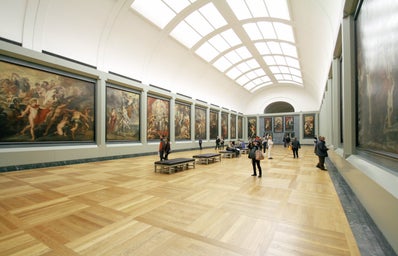Art museums can be overwhelming, even to a seasoned art history nerd. I went to the “Strong Women of the Renaissance” exhibit at the Boston Museum of Fine Arts, and thought it could be the perfect example to walk through for this guide. These five steps are my formula for getting the most out of any art exhibit without requiring any previous knowledge of art.
- Evaluate the room
Without even looking at any of the artwork, the first step should always be to look at how the pieces are being presented to you. What is the color scheme telling you – blank white walls or accents of color? Are the pieces behind glass or exposed? What emotions are you feeling based on the lighting and arrangement?
“The Strong Women of the Renaissance” exhibit incorporated deep, forest greens to offset the ivory walls. Ceramics, linens, prints, and older paintings were shown behind glass while other paintings remained uncovered in their frames. Each item had a short description next to it, giving artist, time period, and medium information. The color scheme channeled dark academia, with the dark green representing vitality, strength, growth, and nobility. The exhibit was organized due to accessibility, items like ceramics and statues were placed more central to be viewed from all sides, while painting and prints lined the walls. The lighting was dim, encouraging introspection, while spotlights cast shadows with careful intention onto statues. Without even looking at the art yet, we can tell so much about what the exhibit is meant to make us feel and what we can expect thematically based on the way the art is presented.
- Read!
The information summaries are there for a reason. After examining the room, you should be able to locate the description specific to the exhibit or gallery room (usually on the wall or a large poster). This overview of the gallery themes should be able to confirm or refute some of the evaluations you made in the first step. From the gallery description, you can discover the overarching themes, background on the artists, and the context of the artwork.
The “Strong Women of the Renaissance” highlighted the disparity in female versus male artists because many women who did become recognized artists were only able to learn because their fathers were artisans themselves. Part of the exhibition showed important female figures as subjects of Renaissance art such as Cleopatra, or as patrons like Isabella d’Este. This information was crucial to distinguish why a piece was chosen for this collection: innovative female artists, inspirational female subjects, or influential female patrons.
- Sink into the artistic experience slowly
Once you have a basic thematic understanding of the room, now take a lap around the gallery. I prefer to start with the outside wall left to right and then move to the center of the room, to make sure nothing is missed. At each piece, don’t look immediately at the information card, back at the painting, and move on – this process leaves you with nothing. The first thing I do is get up close and personal, find the cracks in the panel, the places it’s been touched up by a conservationist, the precise details made up of tiny brushstrokes. Paintings can easily be dated by materials (or mediums), tempera on panel was used prominently in the Gothic period or early Renaissance whereas oil on canvas became more popular in the late Renaissance. Looking closely at brush strokes can help to identify the artist’s style, but even sometimes age. Often artists have much more precision as young adults, and as they progress in age and lose their eyesight, the brush strokes get larger and less intricate.
Titian’s Saint Catherine of Alexandria at Prayer in this collection was painted closer to the end of his life, so there is a noticeable fuzziness in this painting compared to his earlier works. The colors were quite vibrant and it was displayed uncovered, suggesting some recent conservation work.
- Pay Attention to Time Periods and Locations
Now that we have done our initial personal encounter with the artwork, we can look at the information cards. The most important thing to remember is to take these descriptions with a grain of salt – especially with older paintings. Often, collections will claim a painting is by a famous artist to generate more revenue if the work emulates their style, and cannot be proven one way or another no one is likely to question it. Identification of artifacts requires a higher level of guesswork involved than commonly recognized. Keeping that in mind, time periods are more reliable than artist credit, so we can use these to delve deeper into the work. Looking at the time periods and comparing how styles change over time does not require an artistic movement or history degree. Specifically, the shapes of noses, animals faces, and perspective are always noticeable changes throughout especially the Renaissance. It can be fun to explore these trends even without knowing the fancy words for them.
My knowledge of Italian history is not necessarily extensive, so if I need more background on a time period, a quick google search is all I need to figure out what was happening in that region at the time of a painting. Especially when looking at art from the 18th century to present, the time period and location of the artist at that time can give incredible insight into motivation behind the piece and even familiar faces that might have been used in the works. Many Renaissance painters would reveal their political beliefs or bias by painting devils in the likeness of certain political figures and others in the likeness of angels.
- Find your Favorite and Feel
The ultimate goal of art is expression. The final step I take with every piece I look at is how the piece makes me feel. Then I consider how the artist would have wanted me to feel and if the two overlap. Before I walk away, each piece gets rated with a 0 or 1 based on: if it is objectively and aesthetically well done, if I think the artist accomplished their assumed objective through the piece, and my overall personal emotion evoked from the work. Finally, before I leave any specific room of a gallery, I choose an overall favorite artwork.
My favorite piece from this exhibit was without a doubt, The Sleeping Christ Child by Artemisia Gentileschi. She does have an unfair advantage in my rankings because she is already one of my favorite artists, but the other factors overwhelmed even that fact. She went through so much suffering in her life that is evident in the feminine rage expressed in her other paintings – a quintessential heroine of Renaissance Art. Part of why I liked this painting was because it was so different from the Judith and Holofernes aggression I am used to seeing from her. This painting is small and sweet and made me feel safe. The child’s face is all scrunched up in such a realistic representation of a deep sleep. It is beautifully executed and emotionally comforting: a definite gem.
On your next museum visit, use these steps and I guarantee you will impress your friends with your newfound artistic analytical knowledge. The ultimate goal is to walk out with a better understanding of the exhibit rather than if you just floated around reading information cards and glancing at the artwork, occasionally voicing, “That one’s nice”. Art museums are the perfect place to evaluate your emotions in an expressive state, you don’t have to be artistic to enjoy art. I hope these steps help you connect and walk out of that museum feeling refreshed and inspired.


